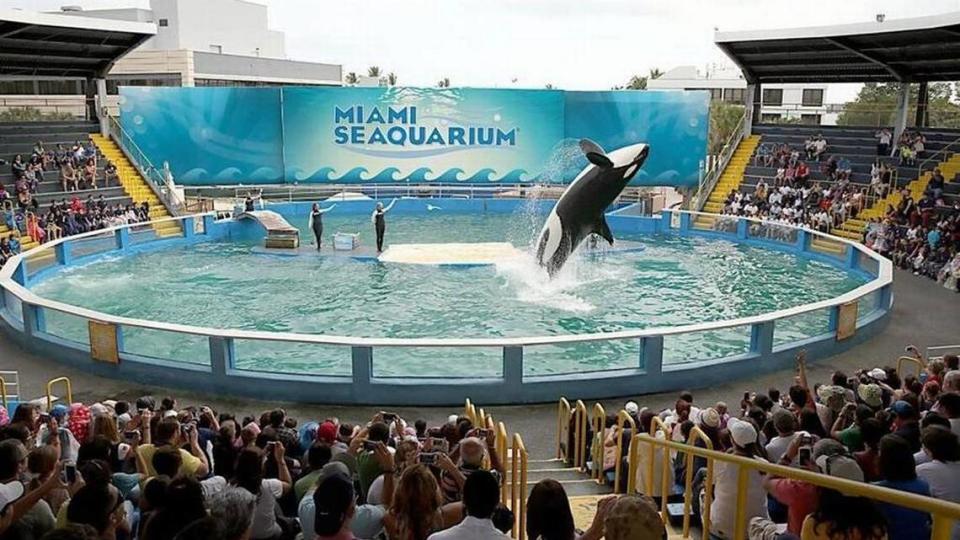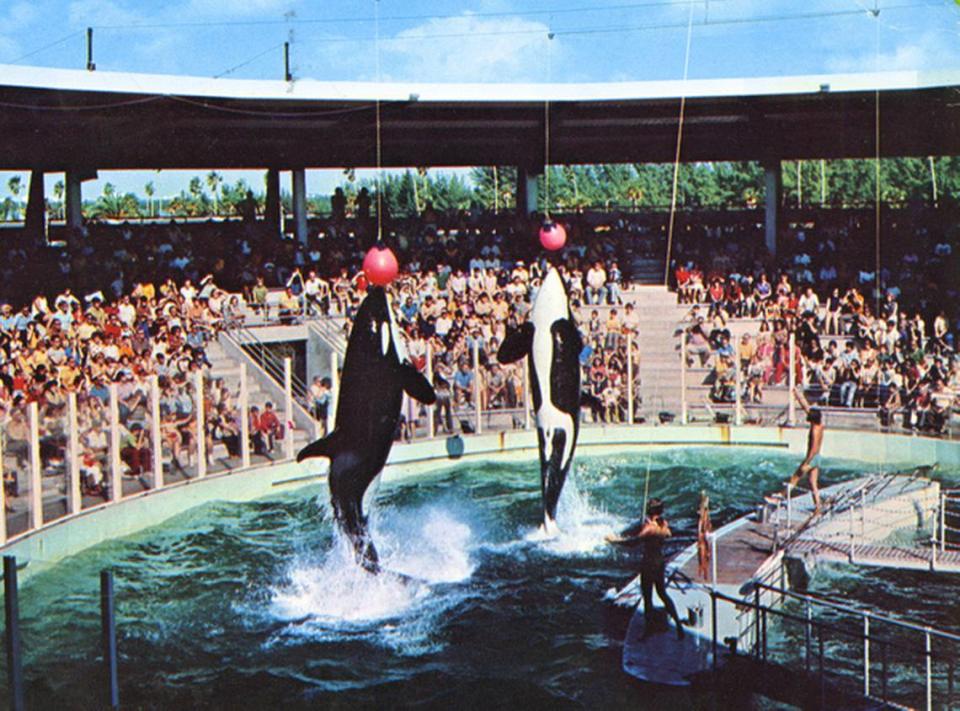A pledge to move Lolita the killer whale from Miami Seaquarium, with Jim Irsay’s help
- Oops!Something went wrong.Please try again later.
Could Lolita the killer whale finally be leaving her cramped tank at Miami Seaquarium and moving back home to Puget Sound?
Obstacles remain, including the logistics of transporting the ailing 57-year-old, 7,000-pound orca from coast to coast and preparing her to live in the wild after five decades in captivity. But Seaquarium plans to announce a “historic initiative” Thursday to “return beloved orca Lolita to her home waters” with funding for the expensive relocation from a new donor, Indianapolis Colts owner Jim Irsay.
The goal is to place Lolita — also known by her Native American name Tokitae and nickname Toki — back in the sea and reunite her with her family, the L pod of southern resident orcas. She was captured in Penn Cove off the coast of Washington in 1970 when she was about 4 years old.
“If she is healthy enough to be transported, the issue is her skill set,” said Miami-Dade Commissioner Raquel Regalado, who has been an advocate for Lolita and improvements at Seaquarium. “She doesn’t know how to catch or hunt. We’re not really sure if she can communicate with other whales because she’s been alone. Now we kind of have to retrain her.”
Lolita’s trainers at the marine park in Virginia Key could be key to the plan, and borrow the methods used to move Keiko — the movie “Free Willy” was based on Keiko’s story — from a marine park tank in Mexico, to an aquarium pool in Oregon, and, in 1998, via a U.S. Air Force cargo plane, to a sea pen in Iceland, from where Keiko later swam to Norway and lived in the ocean for five years before dying of pneumonia.
’She was never meant to live in a tank’
“There is debate about Keiko, and how well he adapted, but I point to his freedom as a victory and proof that he did learn to survive on his own,” said Jared Goodman, People for the Ethical Treatment of Animals (PETA) Foundation vice president and counsel for animal law. “Lolita is the second oldest orca in captivity to Corky at SeaWorld San Diego, but she could have some good years ahead of her. There’s speculation that her mother is still alive. She’s an apex predator. She was never meant to live in a tank.”

Lolita, who was retired from performing a year ago, lives in an 80-foot-long by 35-foot-wide by 20-foot-deep tank in the Whale Bowl, which U.S. Department of Agriculture inspectors have ordered closed to visitors until the stands and the tank are repaired. Lolita, who has been slowly recovering from a serious infection, according to Seaquarium and an independent team of veterinarians monitoring her health, does some of her old tricks from her shows for her trainers for daily stimulation.
READ MORE: Shows are over for Seaquarium’s killer whale Lolita, new managers say. 50-year era ends
“Obviously, the most important thing is her health. Is she healthy enough to be transported? And will she thrive?” Regalado said. “As someone who grew up with Lolita, I think it’s an important step for our community to at least consider all the possibilities. I think it’s something positive for the Seaquarium. They’ll be able to change their focus and lean in more to conservation.”
PETA, which has led protests at Seaquarium calling it an “abusement park,” argues that Lolita should not die in her tank as her partner Hugo did, in 1980, after repeatedly ramming his head into a wall and suffering a brain aneurysm. Her release would “send a clear signal to other parks that the days of confining highly intelligent, far-ranging marine mammals to dismal prisons are done and dusted,” Goodman said.
READ MORE: Inspection finds ‘very thin dolphins’ at Seaquarium. New management defends care
Irsay will join Miami-Dade Mayor Daniella Levine Cava; Eduardo Albor, CEO of Seaquarium’s owner, The Dolphin Company; and Pritam Singh, the real estate investor and founder of the nonprofit Friends of Lolita, which has collaborated in the past with the Whale Sanctuary Project on proposals to move Lolita, always opposed by Seaquarium’s previous owners. They’ve estimated the cost of moving and sustaining an orca in a sea pen to be $15-20 million.
The Whale Sanctuary Project had been working for years to move Kiska, Canada’s last captive orca, from Marineland near Niagara Falls to a 100-acre sea sanctuary enclosed by nets in Nova Scotia. But Kiska, 47, died from a bacterial infection on March 9.
“Kiska was called the ‘loneliest orca’ because she lived by herself for 11 years and all five of her calves died,” said Dr. Jenna Wallace, a former Seaquarium veterinarian. “If Toki dies on the heels of Kiska, it looks like another too-little, too-late failure and may result in more backlash for the Whale Sanctuary Project.”
Government agencies need to OK move
A significant question confronting Seaquarium is how it will acquire permits from the U.S. Department of Agriculture and the National Oceanic and Atmospheric Administration (NOAA) to relocate Lolita. USDA has issued multiple critical inspection reports targeting poor water and food quality, animal deaths and injuries (Lolita’s jaw was injured in a jump) and underfed dolphins at the park, which leases its property from Miami-Dade County.
Irsay is a philanthropist who has donated money to mental health causes and facilities. Last year he donated $1 million to the Indianapolis Zoo. He plays in his own band, and has collected guitars owned by Bob Dylan, Elvis Presley, Prince, John Lennon and Jerry Garcia.
On Tuesday, he tweeted about “a HUGE ANNOUNCEMENT about the future of LOLITA the orca.” Previously he hinted at his participation in the effort to free Lolita, saying he would “need help and ocean blessings. Lots of red tape and hurdles. More info to come on this rescue effort. No guarantees.”


